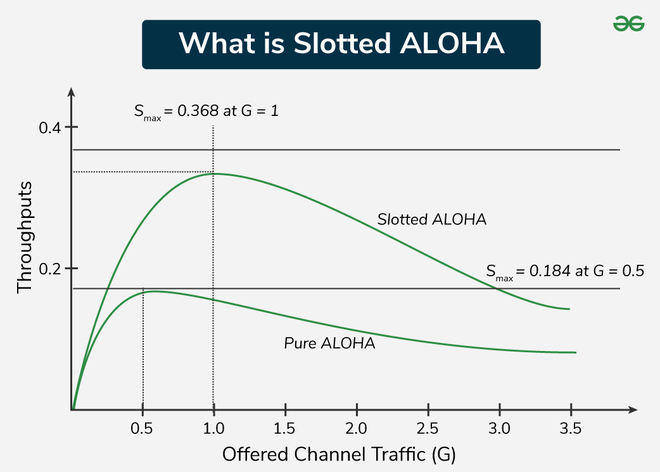
|
|
Slotted ALOHA is an improved version of the pure ALOHA protocol that aims to make communication networks more efficient. In this version, the channel is divided into small, fixed-length time slots and users are only allowed to transmit data at the beginning of each time slot. This synchronization of transmissions reduces the chances of collisions between devices, increasing the overall efficiency of the network. How Does Slotted ALOHA work?The channel time is separated into time slots in slotted ALOHA, and stations are only authorized to transmit at particular times. These time slots correspond to the packet transmission time exactly. All users are then synchronized to these time slots so that whenever a user sends a packet, it must precisely match the next available channel slot. As a result, wasted time due to collisions can be reduced to one packet time or the susceptible period can be half. When a user wants to transmit a frame, it waits until the next time slot and then sends the frame. If the frame is received successfully, the receiver sends an acknowledgment. If the acknowledgment is not received within a time-out period, the sender assumes that the frame was not received and retransmits the frame in the next time slot.  Slotted Aloha Slotted ALOHA increases channel utilization by reducing the number of collisions. However, it also increases the delay for users, as they have to wait for the next time slot to transmit their frames. It’s also worth noting that there is a variant of slotted ALOHA called “non-persistent slotted ALOHA” which is a variation of slotted ALOHA, in this variant the station that wants to send data, first listens to the channel before sending the data. If the channel is busy it waits for a certain time before trying again. Throughput of Slotted ALOHAThe quantity of successful transmissions at each time slot determines the throughput of the Slotted Aloha protocol. The Slotted Aloha protocol has a maximum throughput of about 18.4%. This is because there is a significant risk of collisions when numerous nodes try to transmit at the same time, which causes missed packets and a decreased overall throughput. When less than or equal to 37% of the network’s total nodes are actively transmitting data, the maximum throughput is reached. Due to the high frequency of collisions, the throughput of Slotted Aloha is typically substantially lower than 18.4% in practice It is not a widely used protocol in today’s contemporary networks because of this. The maximum throughput of a slotted ALOHA channel is given by the formula: Throughput (S) = G x e-G
The maximum Throughput occurs at G = 1,
i.e. S = 1/e = 0.368
Where:  Throughput Slotted Aloha The throughput is a function of the offered load and it ranges from 0 to 1. As the offered load increases, the throughput decreases as more collisions occur, resulting in less successful transmissions. The maximum throughput is achieved when the offered load is equal to 0.37 and it is approximately 0.184. It is important to note that the above equation assumes that all the packets are of the same length and that the channel is error-free. In practice, the throughput is usually much lower than this due to a number of factors such as packet errors, channel noise, and the overhead of retransmissions. Assumption of Slotted ALOHA
Advantages of Slotted ALOHA
Disadvantages of Slotted ALOHA
ConclusionIn conclusion, Slotted ALOHA is a method used in communication networks where time is divided into equal slots, and devices can only send data at the beginning of a time slot. This approach reduces the chances of data collisions compared to pure ALOHA, making it more efficient for transmitting data in a shared communication channel. By using time slots, Slotted ALOHA improves the overall network performance, especially when multiple devices are trying to communicate simultaneously. Frequently Asked Questions on Slotted Aloha – FAQsHow does Slotted ALOHA differ from Pure ALOHA?
What is a collision in Slotted ALOHA?
How are collisions handled in Slotted ALOHA?
|
Reffered: https://www.geeksforgeeks.org
| Computer Networks |
| Related |
|---|
| |
| |
| |
| |
| |
Type: | Geek |
Category: | Coding |
Sub Category: | Tutorial |
Uploaded by: | Admin |
Views: | 11 |